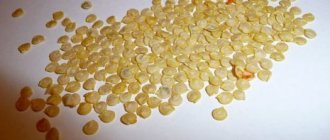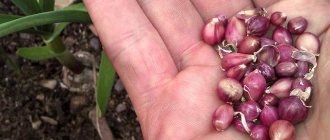Growing rosemary is a simple process, but the plant requires good care. Read more in the article.
Rosemary is a flowering plant that has proven itself to be an excellent spice, which is why it is widely used in cooking. It also gives beautiful flowering and an extraordinary aroma. For these reasons, many summer residents prefer to grow this crop on their own in the garden or garden bed. And there is absolutely nothing complicated about this, you just need to follow a few important, but fairly simple rules.
Read an article on our website about lavender - planting and care in open ground . You will find many useful instructions, photos and videos.
This article describes what types and varieties of rosemary exist, what are its benefits and harms, as well as much other useful information. Read on.
Description of the rosemary plant: general information
Rosemary plant
Rosemary is an evergreen shrub or subshrub from the Lamiaceae family . The Latin translation of the plant's name has a melodic sound - “sea freshness” . However, the shrub does not have an iodine smell. Rather, it has a pine and camphor aroma.
As for the physical parameters of rosemary, they can be characterized as follows:
- This shrub grows in height from 50 cm to 200 cm.
- 3-4 m deep .
- Young shoots are distinguished by their blunt, triangular shape and light gray color.
- Older shoots acquire a dark sulfur tint and a woody structure with peeling bark.
The green mass (leaves) of the plant is linear, sessile, and leathery. The leaf edges are curved downwards, they reach 3.5 cm 4 mm in width . The upper part of the leaves is smooth and shiny, and the lower part is pubescent.
The flowers of the plant are dark or light purple, but they can also be white. Together they form large, dense panicles.
Pinching rosemary
Both in pots and in the garden, rosemary needs pinching to help it grow faster. Usually only young shoots (from 5 to 15 cm of the apical part) are pinched. Plucked or cut rosemary sprigs can be used as a seasoning in cooking, or for growing a new bush.
Timely pinching is the key to good growth
Rosemary plant: types and varieties
You can grow different varieties of this crop, but the most common type is rosemary, the features of which were described above. Although it also has subspecies, including:
- Benenden Blue . This is a fairly compact, erect, miniature bush, crowned with arched shoots.
- Albiflorus . This is the name given to rosemary that blooms white.
- Roseus . Just by the name you can guess that the color of this type of rosemary is pink.
- Seven Sea, Tusken Blue . Quite miniature varieties of rosemary. Such bushes can reach only 50 cm .
There is a variety of common rosemary called “prostratus”. An alternative name is prostrate rosemary. Its height is approximately 50 cm , but its width can grow up to 1.5 m . The leaves of this plant have an unusual appearance. In appearance they resemble pine needles. They are colored in a juicy green color, have a dense consistency, and are distinguished by their meatiness. A white vein is clearly visible in the center.
The color of prostrate rosemary is bluish or lilac. The flowers are small or medium in size. In gardening, this variety of rosemary is often used as ground cover.
Rosemary prostratus
Rosemary prostratus also has several of the most popular types:
- Corsica
- Venzano
- Rosemary creeping
There are also lavender rosemary. It is characterized by slow growth, blue flowers and small bright green leaves. For home growing, choose any variety you like.
Worth knowing: Rosemary is very easy to grow at home and in the open ground. It does not require special care and is characterized by high resistance to phytopathologies.
What kind of rosemary is available on sale?
Specialized stores offer rosemary varieties to gardeners:
- Semko, Tenderness, Vishnyakovsky, Rosinka (developed by Russian breeders);
- Severn Sea (grows to a maximum of half a meter);
- Prostpatus (shoots spread along the ground, carpet height 15 cm);
- Roseus (distinguished by pink-tinged flowers);
- Albiflorus (decorated with white flowers).
Foreign varieties are particularly decorative.
Properties of rosemary: harm and benefit
The plant is popular not only in cooking, gardening and landscape design. Its beneficial properties have long been known, due to which it is used in alternative medicine. What are the benefits of this plant?
Medicinal properties of rosemary - the culture has a wide range of therapeutic properties, including:
- Choleretic
- Antioxidant
- Anti-inflammatory
- Hypertensive
- Invigorating
- Regenerating
Thanks to this list of rosemary’s medicinal abilities, this plant is used in medicine for:
- General exhaustion of the body
- Rheumatism
- Menopausal disorders
- Radiculitis
- Impotence
- Hypotonic disease
- Cold pathologies
- Certain cardiac disorders
- Obesity and cellulite
- Disorders of the circulatory system
In addition, the plant perfectly fights the aging of the body. For this reason, it is quite advisable to use it in home cosmetology. Rosemary oil is considered the most valuable product. It is used in the treatment of:
- Furunculosis
- eel
- Eczema
- Infected wounds
The product is obtained by processing young shoots, flowers and leaves of the crop. In this case, the method of steam treatment of these parts of the plant is used.
Despite all the benefits of rosemary, it can be harmful to health if you have an individual intolerance or allergy. In this case, it is prohibited to consume such a plant internally. Also, you should not use rosemary if there are contraindications. These include:
- Pregnancy period
- Epilepsy
- Tendency to seizures
- Hypertension and arterial hypertension
- Individual intolerance to the components contained in the plant
Rosemary is also prohibited for children under 9 years of age . This applies not only to herbs, but also to any products that are obtained from raw materials - oils, infusions, extracts, etc.
Rules for collecting and procuring raw materials
Collecting rosemary shoots is best done in dry weather. The readiness of greenery for cutting depends on the variety, the average time is from 4 to 6 months after germination.
The branches are cut, dried in a dark, ventilated room, and crushed. Place in airtight spice jars and store in a dark, cool place.
By following the conditions for sowing and growing rosemary, you can get a spicy bush that grows on your property in summer and in a pot at home in winter. It's convenient to have seasoning on hand.
Do you find growing rosemary from seeds difficult? Do you know the beneficial properties of rosemary? Share the article with your friends and acquaintances. Be sure to save the article in your bookmarks so as not to lose it for the next planting season.
Planting rosemary for growing in open ground
Planting rosemary for growing in open ground
The main condition for the successful cultivation of rosemary is the correct and well-chosen place for picking seedlings. This is a sunny zone protected from drafts and wind. As for the composition of the substrate, it is desirable that it be calcareous, loose and light. Equally important is proper drainage of the land.
It is best to plant seedlings in the 3rd-4th week of May . By this time, the seedlings will reach 7-8 cm in length and will be able to take root well in the soil. If you are going to grow large bushes of the crop, then plant the seedlings at a distance of 50 cm from each other. If large-scale propagation of the plant is not planned, then a 10 cm gap from bush to bush in open ground is sufficient.
Important: After picking, do not forget to water the seedlings!
How to grow rosemary at home on a windowsill from seeds
Growing spices at home is not difficult: you need to germinate the seeds in the indicated way, plant the seedlings in separate containers, and as they grow, transplant the plants into larger pots instead of open ground.
Important! It is necessary to trim the tops in a timely manner and shape the bush so that it does not grow excessively upward.
Due to its properties and variety of uses, rosemary is increasingly becoming a plant grown on windowsills. The main thing is that it gets enough sunlight - then it will delight with its rich aroma and bright color.
Dates for planting rosemary in different regions of Russia, Belarus, Ukraine
Planting rosemary for growing in open ground
In central Russia (Moscow region, Leningrad region, Samara, Volgograd, etc. ), the time for planting rosemary is the end of May . It is important that the soil warms up and there are more sunny days outside than cold and rainy ones. Gardeners in Belarus .
In warmer regions (Krasnodar, Crimea) you can plant this seasoning in early May . At this time, in the southern regions it is already warm not only during the day, but also at night. The earth is warm, the sun shines brightly during the day. In Ukraine , the plant is also planted in open ground at this time. Many gardeners, during a warm spring, plant rosemary in the soil at the end of April.
In the Urals , gardeners grow the plant in the same way as in other regions. Just plant the seedlings in open ground a little later - early June . At this time, the earth is already warmed up, and the air temperature does not fall below 12°C . It is colder in Siberia, so the seasoning is grown only in pots on the windowsill or in heated greenhouses.
Growing rosemary in the Middle Zone
It is known that rosemary is a heat-loving plant, so many gardeners have a question: how to plant rosemary if there is practically no sun at the dacha?
Rosemary: where to plant in the garden
Before planting the plant, you need to decide whether rosemary will be a perennial or an annual? The plant itself is a perennial, but it is not always possible to provide it with conditions for wintering or to replant it, so sometimes it is grown only for one season. In the Moscow region and in general regions with cold winters, this is an annual plant.
Planting rosemary should take care of the seedling
In any case, it is important to remember that the spice loves the sun and warmth, and does not tolerate temperature changes, cold weather or excess moisture. Therefore, the optimal place to plant it will be the south or east side, well illuminated by the sun. It is best to plant shrubs along the south side of the house - it will protect the plant from strong winds, and a light, pleasant aroma will reign in the rooms.
It is imperative to choose a place where water does not stagnate, otherwise the plant will die very quickly. Thyme, basil, bay, dill and parsley will be good neighbors for rosemary. Some gardeners also plant it next to cucumbers and various members of the nightshade family, as the aroma of the plant repels pests well. But mustard and horseradish will quickly destroy their Mediterranean neighbor.
Priming
It is best to plant the spice in permeable, sandy soil containing plenty of nutrients. It is important that the soil is well drained and has an acid-base balance of 6-7 units. Soils that are too acidic or too alkaline will destroy the plant.
You can make the optimal soil yourself by taking 2 parts compost, part lime sand and part small stones. Instead of lime sand, you can use any other sand, but in this case you will need dolomite additives, in the amount of a couple of spoons for every 5 liters of the resulting mixture.
Feeding
For better health and growth of the bush, it must be fed in a timely manner. The ideal feeding scheme would be the following sequence: nitrogen fertilizers are applied in the spring, complex fertilizers in the summer, and phosphorus fertilizers in the winter. This nutrition will allow the grass to grow well.
Important! Phosphorus fertilizers include superphosphate and ammophos, nitrogen fertilizers include ammonium nitrate, ammonium sulfate and ammonium sulfonitrate.
How to grow rosemary in open ground: winter care features
Rosemary is not considered a fussy plant. It grows well in open areas, but it also requires care. However, this process will not take much effort or time. It is enough just to follow basic procedures that will help the crop develop, and also protect it as much as possible in the open ground from the invasion of harmful insects. Features of winter care:
- As mentioned above, rosemary does not tolerate low temperatures, and, for example, it may not survive the winter near Moscow.
- For this reason, when cold weather sets in, it is recommended to transplant it into a container of the required volume and width, and move it to a room where the air temperature is +16 °C.
- If for some reason you cannot do this, then prune the bush at soil surface level. Cover it with dry sawdust or leaves on top. And around the bush, make a small tent from spruce or pine branches.
How is pruning done correctly? Read on.
How to plant: timing, methods, tricks
In order to grow rosemary in open ground, you can use several planting methods. Each method has its own nuances, so read them carefully and choose the one that suits you.
Recent Entries
5 working ways to use tar in the garden 7 indoor plants that help you get married even in adulthood Indoor plants that can bloom in trouble
Preparing the soil for planting rosemary
First of all, you need to take care of the soil in which the shrub will be planted. Please note that spicy greens do not like lowlands and flooded areas. Therefore, for planting, choose a place with a flat surface, but avoid drafts.
Most of all, rosemary does not like acidic, heavy soil. In order to please the bush, prepare a simple substrate: mix black soil with dry leaves, some neutral peat and sand. Take all components in equal parts. Then add crushed lime to the substrate in the ratio of 100 g of lime per 10 buckets of substrate.
Beds for future shrubs should begin to be prepared 7–10 days before planting. The soil under them needs to be moistened in advance, and 3-4 days before planting, add mineral fertilizer to it.
Growing from seeds in spring
Germination should begin in early spring. Seeds are grown indoors. To do this, you usually take several containers (the main thing is that they are suitable for growing flowers). Of course, you can sow the seeds directly into the ground, but there is no guarantee that the temperature will be consistently warm, and even with this method of growing, you will only see your rosemary closer to autumn. Therefore, for those who want to be sure to see their brainchild in the summer, we advise you to sow the seeds indoors approximately at the end of February.
Rules and instructions for growing rosemary using seeds:
- Take clean gauze and fold it into several layers so that you can put some seeds on one part and cover them with the other.
- Soak one half of gauze in water and spread the seeds on it in a thin layer. After this, cover them with the second half of damp gauze.
- Use a spray bottle to moisten the gauze daily. In the room where the seeds germinate, the temperature must be constantly maintained at 19–23°C.
- The soil in which rosemary will be planted should be prepared in advance.
- After 3–5 days, collect the seeds and sow them in a thin layer, cover it with soil (the layer should not exceed 5 mm). Moisten the soil with a spray bottle and cover the container with the planted seeds with polyethylene (you need to make holes in it first), then place the container in a warm place.
- Water the soil three times a day, ideally using a sprayer to avoid accidentally washing away the soil and exposing the seeds.
- After about 14 days, you will notice small rosemary sprouts. When the first shoots appear above the ground, remove the plastic and place the containers with the sprouts in the sun.
- After a couple of months, the sprouts should already be completely strong for planting. Moving into the ground is not so difficult: you just need to carefully dig up the sprouts and plant them in the beds.
- Immediately after transplanting rosemary, the soil needs to be moistened.
Spring cuttings
Growing spices this way is much easier. In this case, the cuttings will be the tops of the shoots, which are cut from an adult bush. The best time for cuttings is April or early May.
You can also use those bunches of greens that are sold on the market as a spice as cuttings.
Rules for growing rosemary using cuttings:
- Remove the lower leaves from the branches, partially exposing the stem.
- Place the branches in water and wait until the roots sprout from them (you can, of course, plant them in a pot of soil and wait until the roots sprout there, but the method with water is more effective and clearer). After the roots have appeared, the stems are ready to be transplanted into open ground.
- The water under the stems needs to be changed every 3-4 days. If you use the pot method, water the sprouts every other day, but do not overdo it with the amount of water.
- Noticeable roots should appear in about 20 days. As soon as this happens, you should immediately transfer the cuttings to the prepared beds. The stems should be planted in holes with a depth equal to the length of the roots. Water the soil under the planted young plants.
Growing by division in summer
Dividing is the easiest way to get spices in your garden. It does not require preliminary home manipulations such as germination, and immediately makes it possible to plant rosemary in open ground. This is best done in June.
Division:
- Prepare the soil for planting according to the instructions above.
- Next, you should get a bush with a large number of shoots (you can look for one in the store or from someone you know).
- The roots should be removed from the ground and shaken off.
- Dig holes in the soil with a depth equal to the length of the roots and plant the sprouts.
- Water the soil.
Main features of caring for rosemary when growing: pruning
Pruning rosemary
7 days after planting rosemary seedlings in the ground, pinch the tops of the shoots from the crop. This is necessary in order to stimulate the process of formation of full-fledged bushes. But keep in mind that rosemary will bloom for the first time only a year after planting in the soil.
When the crop reaches two years of age, do not forget to trim off last year's growth. This must be done every April, cutting out all shoots located at ground level. But this is only the case if we are talking about straight-growing rosemary. A prostrate plant variety does not need to be pruned.
Remember: Once every 7 years, carry out anti-aging pruning of bushes. It is also best done in the spring.
Care
Rosemary is a southern plant that needs to be created as close as possible to its “native” conditions. Growing and caring for this shrub in a temperate climate is complicated by frosty winters - even with insulation, it can freeze and die. But otherwise, rosemary is hardy and is able to develop normally even with minor mistakes on the part of the grower.
Watering
The shrub can develop in dry conditions, but if comfortable conditions are provided, rosemary should be watered regularly. Moderately moist soil is best for it. To create such conditions, during dry hot periods the shrub is watered once every 2 days, and when it is relatively cool - once every 3-4 days. This watering regime will help rosemary feel good, but it is not always suitable.
A rosemary bush can signal that it is necessary to change the watering system by changing its appearance. When the foliage on a plant begins to darken and fly off, this indicates that the soil is overly moistened and watering should be reduced. If the leaves on rosemary turn yellow and curl, then the bush lacks water and the frequency or volume of watering must be increased.
Reference!
In order for the soil on the site to acquire a drainage effect, it is periodically loosened. This measure ensures that the soil is saturated with air and ensures that excess moisture is removed from the roots of the plant, preventing them from rotting.
Feeding and pruning
You may be interested in: How to grow rosemary in open ground and care features How to grow rosemary in an apartment The benefits and harms of rosemary leaves
For normal development, the shrub needs a site where weeds will not grow, actively drawing away useful components. Therefore, be sure to weed the rosemary bush as they sprout, and also along with loosening, that is, once every 20-30 days. This will rid rosemary of unwanted proximity and at the same time prevent overflow. To ensure that the bush can grow well, it is regularly fed. The procedure is performed twice a month, and in winter no fertilizer is applied.
How to feed rosemary:
- an aqueous solution of mullein in a ratio of 1:5 - in any season;
- nitrogen mineral-organic preparations - in spring;
- phosphorus mineral-organic preparations - in autumn;
- mineral compositions with calcium - in summer.
Pruning rosemary is a mandatory procedure for upright shrubs; thanks to it, they not only grow well, but also look beautiful, just like in the photo. If it is a creeping species, then only rejuvenating is done; annual ones are not necessary. The branches of the bush are shortened annually after they reach 2 years. Rosemary should be pruned at the end of spring, keeping up to 4 internodes on the shoots of last year's growth. When an adult specimen becomes bare, the lower shoots are cut off. Every 7-8 years, the plant is completely rejuvenated by cutting off its entire above-ground part, leaving a small stump. Anti-aging pruning is not carried out if there are signs of bush disease.
Wintering
Depending on the planned option for growing rosemary in open ground and the expected duration of its life, the wintering method is chosen. When it was decided that the shrub should be grown as an annual - the seeds were sprouted and completely cut off in the fall, then wintering was not organized. The roots of the plant are left without insulation and the rosemary freezes. When it is grown as a perennial, the wintering option depends on the degree of temperature drop:
- -4˚ C and above – the bush will survive the winter on its own;
- -5…-8˚ C – the shoots are cut off, the rhizome is insulated with sawdust and dried grass;
- -9˚ C and below – you need to transplant rosemary in the fall into a greenhouse or container.
When wintering indoors, the temperature must be in the range of +10...+16˚ C, it is allowed to drop to +5˚ C, but not lower. The room is regularly ventilated, and the bush is watered with lukewarm (+18...+24˚ C) settled, rain or melt water. When the plant overwinters in a poorly heated room, it is advisable to protect the foliage of the rosemary bush from moisture. During the wintering period, rosemary must be supplemented with light, providing it with 6 hours of daylight using a phyto-lamp, otherwise the bush may die.
Attention!
Mulching helps the plant survive wintering normally, as it reduces the impact of temperature changes on rosemary. Sawdust, dry leaves, ground tree bark and other similar organic materials are used as mulch.
Diseases and pests
Due to the intensity of the aroma, the rosemary bush is rarely attacked by harmful insects. But when the plant is weakened, the intensity of the smell and its strength decrease and some pests can attack rosemary. Among these insects there are cobwebs and scale insects. To eliminate them, the rosemary bush is treated with insecticides or other, more potent drugs, for example Actellik.
Rosemary diseases appear due to deterioration or improper care. The plant may be affected by powdery mildew, which appears as whitish spots. If you normalize the watering regime and treat with fungicides, rosemary can be saved. But when the specimen is already severely damaged, it is impossible to save it. In most cases, rosemary gets sick during wintering, so you need to regularly check the condition of the bush and start treating it in time.
What to plant after rosemary?
Replanting rosemary or completely removing the bush is an optional procedure. It can be done at will, but the plants must be planted or the “correct” crops sown in place. According to crop rotation, after plants that are valuable above ground, it is worth planting crops whose tubers are valued. Therefore, uprooted rosemary bushes can be replaced:
- Garlic
- Carrot
- Bow
- Beetroot
- Potatoes, etc.
After removing the bush, make sure that the ground is completely cleared and there are no remnants of roots or shoots of the plant anywhere. Then dig up the area and apply fertilizer to it. Regular humus or compost will do.
How does rosemary propagate?
Anemones - growing and care in open ground
Rosemary propagates in several ways. Particularly popular among gardeners is germinating seeds and rooting cuttings. Reproduction methods by air layering and dividing the bush are also used.
Germination of seeds
How to plant rosemary in the country using seeds:
- Prepare containers for planting with loose soil.
- The seeds are soaked in warm water several hours before the procedure. They should swell.
- The soil is moistened in advance.
- Place the seeds in prepared pots to a depth of no more than 4 centimeters.
- The container is taken to a warm and dry place. It is important to maintain the temperature within 25 degrees and avoid drafts.
After planting, you need to periodically spray the soil when the top layer dries out.
With proper care, seedlings will become noticeable in 2-3 months. You can transplant them to a permanent place when they get stronger. They are usually about 6 centimeters long.
Rooting cuttings
Cuttings for planting are cut at the end of September. In this case, they take small branches and divide them into parts so that the length of each does not exceed 10 centimeters. They must have at least three internodes.
Cuttings
Cut cuttings are treated with a root growth stimulating agent and placed in nutrient soil. The soil must be moistened periodically, not allowed to dry out, but also avoid excessive watering. After new leaves appear, young plants are planted in separate pots.
Note! There is no need to take large containers; the diameter should not exceed 10 centimeters. 1-2 weeks after transplantation, it is better to remove the tops of the plant so that they produce new shoots and form a branched shrub.
Air layering
Air layering is very easy to propagate. You just need to bend the branch to the ground and sprinkle it with soil, fixing it in place. If this is not enough, you can put a stone on top. The soil around it needs to be moistened.
When roots appear, the plant is ready for independent life. You can carefully cut it off and transplant it to a permanent place. Usually the roots become noticeable after 1.5-2 months. Depending on weather conditions, the date may change.
Dividing the bush
Dividing the bush is more suitable for indoor plants. Rosemary must be removed from the container and damaged areas removed. Carefully divide it into 2 or 3 parts, making sure that both shoots and roots remain on each. Treat the cut areas with charcoal powder, this will prevent the penetration of infection and disinfect. After this, new plants can be planted in separate containers or a place on the site if it grows in the garden.
Propagation of rosemary when grown in open ground: seeds, seedlings
Propagation of rosemary when grown in open ground
The most common method of propagating rosemary when grown in open ground is by seed. That is, using the sowing method, you can grow several rosemary bushes at once. But this is not the only option. You can also increase the number of shrubs with the help of seedlings, which is done by:
- Cuttings
- Layerings
- Divisions
Each of these methods has its own characteristics and secrets. Take them into account so that your work produces a positive result.
CUTTINGS:
- To propagate rosemary by cuttings, you must wait until autumn. The work is best carried out in September or October.
- Cut small pieces from annual shoots. It is enough that their length is 8-10 cm , and three or four internodes.
- Free the lower parts of the cuttings from green matter, and place the cut area in a root formation stimulator.
- Then plant the resulting cuttings in a container with light, slightly loose, well-drained, and most importantly, sterile soil. This can be peat combined with vermiculite.
- Place the seedlings in a warm place and do not expose them to sunlight.
Remember that the substrate in the container must be kept moist. Also, do not forget to spray the cuttings themselves daily. When fresh green mass appears on their surface, plant them in separate pots with a diameter of 7 to 9 cm . After 7 days , pinch the tops of the cuttings - this is important to stimulate the branching process.
REPRODUCTION BY LOCATIONS:
- The principle of using this method of propagating rosemary is also quite simple.
- Tilt the lowest growing shoot of the bush towards the ground and secure it securely.
- Dig it down lightly, but do it so that the top is above the soil surface.
- Water the resulting layering along with the main bush.
- The soil that covers it should be slightly moist at all times.
- When you notice that the top has begun to grow, separate the cuttings from the mother bush and plant them in a garden bed or small flower pot.
REPRODUCTION BY DIVISION:
- Typically, the division method is used when propagating indoor rosemary.
- All for the reason that to obtain planting material it is necessary to get to the roots.
- But when growing crops in open ground, this is almost impossible.
- Therefore, it is not advisable to consider this method of reproduction in the current case.
If you grow rosemary in open ground, then cuttings and seed methods are well suited for propagation. Experienced gardeners use them.
Growing seedlings and transferring them to the garden
Seeds are planted in February.
Place gauze in a saucer, place grains on it and cover with a second layer of gauze. Pour settled warm water and leave to germinate at a temperature of 18-22 0C. Maintain humidity using a sprayer for 3-5 days. Then the germinated seeds are planted in pots or cups. 1/3 of the volume is filled with drainage, the rest of the space with soil mixture. There are holes at the bottom of each container to remove excess moisture.
The seeds contain a large amount of essential oils, so they are oily to the touch. To plant, you should carefully pick them up with a damp toothpick. No recesses are made in this case. The grains are placed on top of the ground, sprinkled with 2-3 mm of soil on top.
The container is covered with a breathable film or a plastic or glass lid. Every day the covering is removed and the plant is allowed to air for 30-60 minutes. The lid is removed completely when the first leaves appear. The room chosen is bright and warm. The optimal temperature for growth is 25-30 0C.
Pests and diseases of rosemary growing in open ground: how to protect the plant?
Downy mildew - a disease of rosemary
Rosemary, growing in open ground, is extremely resistant to various types of infections, diseases and pests. Rarely, only he can be affected:
- aphids
- Downy mildew
- Whitefly
How to protect a plant? Here are some tips:
- You can get rid of harmful insects by soaping the green mass of rosemary.
- After this, carefully remove the remaining soap with a stream of running water.
- But make sure that soapy water does not get on the soil, so cover it with film before the procedure.
- Also watch the humidity - it should not be high. Although when such manipulation is carried out in the open air, an increase in its level is practically excluded.
In special stores you can buy products to combat pests and plant diseases. Read in another article on our website how you can treat your garden and vegetable garden in the spring .
But you can also use folk recipes. Eg:
- Birch tar - from various insects
- Bay leaf - decoctions
- Treatment of plants with iodine
Try to use natural, safe products to treat this plant. After all, you will use the leaves as a seasoning or medicine, and there is no need to treat them with toxic pesticides.
The culture is propagated in different ways, and it grows well in open soil or in the house. And with its wonderful flowering and unusual aroma, the culture has justifiably earned the love of many gardeners. Do you grow rosemary at home or in the garden? What secrets do you use to care for him? Please write in the comments.
Wintering and pruning
Rosemary cannot withstand frost and dies at -10 0C, so when growing perennials, they think in advance about how to cover them for the winter. There are 2 options:
Lay the roots with dry leaves and spruce or pine branches, and cover with film on top. The method is suitable only for the southern regions of the country, where the climate allows you to leave shrubs outside.
They are dug up and planted in pots, which are left to overwinter at home or in a greenhouse. It is not necessary for the room to be hot; above-zero temperatures are sufficient.
If you plan to leave perennials outside, you cannot prune them before. This will weaken the plant’s immunity and it will die.
Pruning dried, damaged, and simply overgrown branches is a mandatory condition of care. The bushes are completely removed at the root at the end of September if planting was planned for one season. Perennials are cut down every 8 years. Medicinal varieties are harvested in sunny weather. Figure cutting to decorate the landscape is performed in March-April.
Brief description of cultivation
- Landing . Rosemary seeds are sown for seedlings in the last days of February or the first days of March, and the seedlings are transplanted into open ground from mid to late May.
- Illumination . A large amount of bright sunlight is needed.
- Soil . Calcareous, well permeable to water and air.
- Watering . Should be moderate. Water is poured carefully under the root to avoid drops falling on the surface of the leaf blades.
- Fertilizer . In spring, nitrogen-containing fertilizer, for example, urea or ammonium nitrate, is added to the soil on the site. After this, once every 30 days, rosemary is fertilized with a solution of complex mineral fertilizer. In autumn, fertilizers that contain only phosphorus and potassium are used.
- Reproduction . By cuttings, dividing the bush, seeds and layering.
- Harmful insects . In indoor conditions - whiteflies and aphids, in open ground - aphids.
- Diseases . In winter, in indoor conditions, the plant can get downy mildew.
Planting rosemary seedlings
What time to sow seedlings
To propagate rosemary, they use the seed method, cuttings, dividing the bush and layering. In regions where winters are cold, this plant is recommended to be grown from seeds through seedlings. Sowing of seeds is carried out in the last days of February or the first days of March.
Features of sowing
Before sowing, the seed material is kept in water for several hours. When the seeds swell, they are sown in moistened sand or vermiculite, and they need to be buried only 0.3–0.4 cm into the substrate, and the container must be covered with film on top. If you want seedlings to appear as soon as possible, the crops are constantly kept warm (25 to 30 degrees). Do not forget to systematically remove the shelter and moisten the substrate with a spray bottle so that it is always slightly damp. If everything is done correctly, the first seedlings should appear after 6–8 weeks. Immediately after this, the shelter is removed, and the crops are moved to a well-lit place. Remember that the substrate in the container must be watered regularly; for this, use warm, well-settled water. After the height of the seedlings is 70–80 mm, they are planted in open ground.
An easy way to sow rosemary.
Rosemary harvesting and preparation
Young leaves and the tops of green, non-woody shoots are cut off from rosemary. They are used in cooking as a spice and for medicinal purposes. The best time to harvest rosemary is during the flowering period, when the plant has the highest concentration of beneficial components. This time occurs differently, depending on the variety, but most often the shrub blooms in mid-spring and, under good growing conditions and warm weather, until early November. Harvest rosemary on a sunny and windless day.











